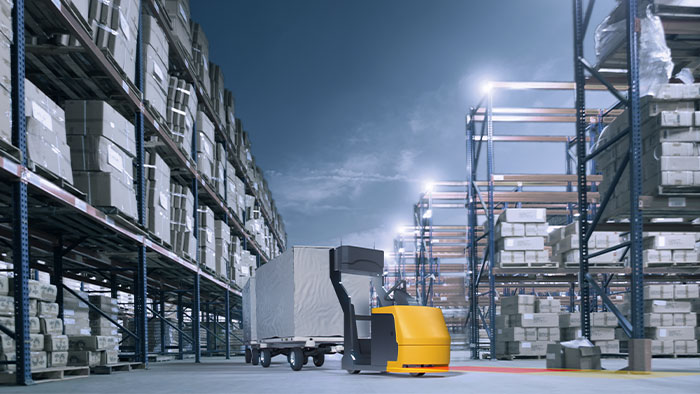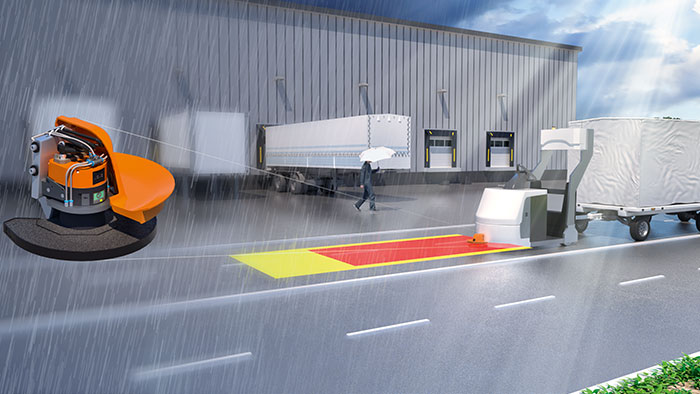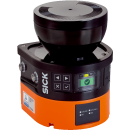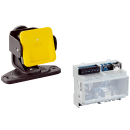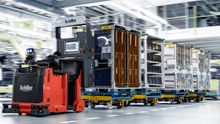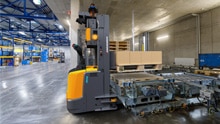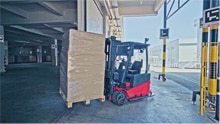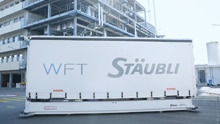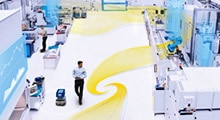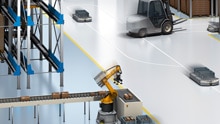Exciting times for intralogistics specialists – automated guided vehicles (AGVs) are increasingly being used in outdoor applications, thereby bringing within reach the goal of ensuring a weather-independent and automated material and goods flow around the clock. SICK, with its holistic approach, its in-depth process understanding, and its comprehensive portfolio of sensor solutions is well placed to tackle the many issues associated with functional safety in outdoor applications.
Holistic view of functional safety for seamless intralogistics
“Customer applications in outdoor settings are challenging and unique, and always require a precise analysis of the relevant application parameters. There exist, nevertheless, many commonalities as the issues and problems faced by our customers are often astonishingly similar.” Michael Badeja, Strategic Product Manager at SICK and an expert in outdoor applications, knows from experience that it is essential to have precise knowledge of the specific tasks on site in order to come up with the best possible solution based on SICK’s comprehensive offerings. Whether it be sensor components and sensor systems, software, controllers, or lifetime services and advice, they are all available globally from a single source.
Putting together a complete package – but correctly
“The objective is to put together the complete package correctly. The first step is to determine all the things that could affect the safety solution of the AGV when it is operated outdoors. By doing so, we reduce in the end the effort required to implement the particular automation solution.” Badeja therefore first analyses in conjunction with the customer the basic application requirements, such as vehicle type, transported goods, location and route. The size, weight and in particular the design of the AGV determines whether it is an underride vehicle, a platform vehicle, or a tugger. The dimensions of the transported goods, and the dimensions, characteristics and stability of the load and load carrier need to be precisely defined and taken into consideration, in particular their behavior in poor weather conditions. The regional and local climatic conditions need to be carefully considered for each location-specific sensor solution. This is because customers around the world face a wide variety of climatic challenges, from continental fog and precipitation scenarios right through to tropical and subtropical heavy rainfall events. Locally arising climate phenomenon, for example wind corridors between factory buildings, also have an impact.
Listening well and being on site
“We listen carefully to the customer and ideally visualize the situation on site, preferably with the integrator and the end customer at the same table. Particularly when it comes to analyzing the route and the required safety functions, the specific circumstances in the logistics area present a wide variety of requirements when selecting the correct safety solution and its configuration,” emphasizes Badeja. Will the route be fixed along magnetic tapes, or free with GPS-assisted navigation? Are there any critical curves, ramps, steps or other irregularities, for example rails? What are the floor characteristics? What collision risks with people, other vehicles or fixed obstacles could arise? If it is planned to operate the AGV in both indoor and outdoor areas, could temperature differences lead to condensation on optical surfaces that needs to be countered with technical measures and operating profiles. Application-relevant local obstacles also need to be taken into consideration: Are there covered areas, can paths get flooded, or will steam be escaping from manhole covers in certain locations? Only by knowing the local conditions precisely can the safety experts from SICK select the appropriate hardware, software, accessories and service offerings from their holistic and comprehensive portfolio.
Complementary technologies and smart accessories from a one-stop-shop The outdoorScan3 safety laser scanner, for example, offers not only a high safety integrity level in accordance with the normative requirements on functional safety, but also at the same time a high availability in poor weather conditions, thereby ensuring greater productivity in outdoor areas. If the rain becomes too strong, e.g. at 10 to 30 millimeters per hour, the water spray or rain hitting the sensor and negatively affecting the safety-critical task can become a challenge. SICK has recently developed a smart accessory for this: The airWiper removes water drops from the optics cover using compressed air and functions like a “windshield wiper” made of air. The airWiper can be purchased not only for new installations but also as an upgrade for existing outdoorScan3 devices. If the amount of precipitation increases to more than 30 millimeters, which can be the case during brief storms, limitations in availability will arise: “The question then is whether the vehicle is able to be brought to a stop, whether it needs to continue on its way automatically, or in exceptional cases whether the vehicle will then need to be manually operated in order to maintain the logistics chain”, explains Badeja.
For more harsh environments that require a level of accuracy in the millimeter range for the environment perception, the safety expert recommends switching from the 2D world to the 3D world and implementing safe radar systems such as the SafeRS3: “The radar sensors significantly extend the field of view and are the ideal safety solution, for example, for transit zones between loading stations where few persons or other traffic are present as well as for more simple ambient conditions. In these situations the radar sensor technology allows the vehicle to travel at higher speeds and navigate around obstacles, even in very poor weather. Using an intelligent combination of different sensor technologies, we are able to not only avoid interruptions in productivity but even increase the productivity overall.” Thanks to this portfolio of complementary technologies, SICK's customers can always obtain a solution tailored to their specific application.
Software components increase availability
In addition to the hardware, SICK also supplies software components that have a positive impact on the availability of the AGVs in outdoor areas. The AGV Dynamic Weather Assist safety system with weather-independent dynamic protective field switching, for example, allows continuous operation even during strong rain or snowfall. Instead of stopping, the AGVs can automatically adjust their speed and protective field parameters to the particular precipitation situation. This avoids unplanned vehicle stops and thus weather-related interruptions to the material flow, and also protects the brakes and mechanics.
Another tool that SICK and the customer can jointly use to develop effective solutions is the Monitoring Box. This digital solution for ongoing monitoring of the device and system status as well as the application itself increases the productivity in a targeted manner. From the analyzed data it creates diagnostics, statistics and prognoses that make predictive and needs-based maintenance possible. It enables the devices and systems to operate in the high-performance range and use resources efficiently. It is a suitable tool for systematically monitoring and optimizing the productivity, in particular for outdoor applications.
Services for efficient and safe solutions
The services from SICK support the user with holistic solution approaches for implementing applications efficiently and safely. Working in a close partnership with customers, the experts at SICK develop innovative solutions that are very much focused on optimizing existing applications in regards to productivity and safety. The portfolio of offerings extends from simple solution suggestions right through to the complete implementation of complex applications. This enables customers to concentrate fully on their core tasks and, trusting in SICK’s longstanding experience in the area of efficient and safe sensor technologies, to successfully meet the constantly changing challenges in the field of outdoor logistics.
